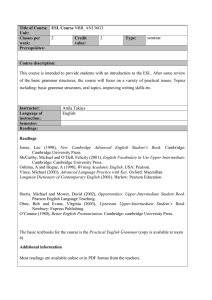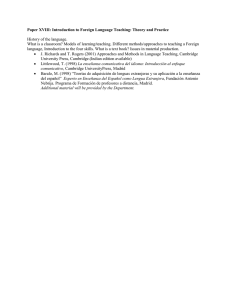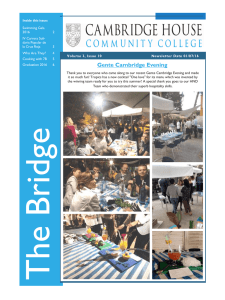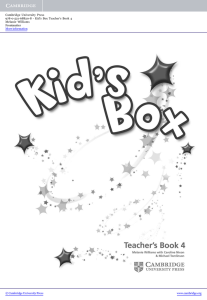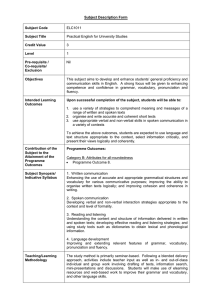Cambridge Certificate in Advanced English 4
Anuncio
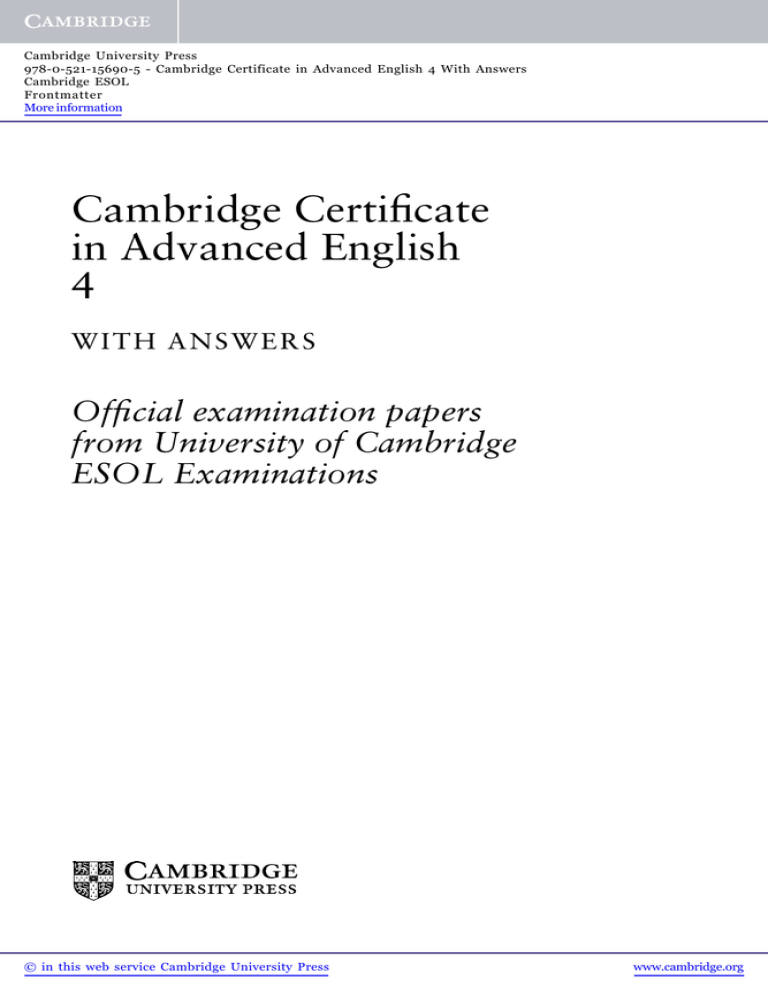
Cambridge University Press 978-0-521-15690-5 - Cambridge Certificate in Advanced English 4 With Answers Cambridge ESOL Frontmatter More information Cambridge Certificate in Advanced English 4 WITH ANSWERS Official examination papers from University of Cambridge ESOL Examinations © in this web service Cambridge University Press www.cambridge.org Cambridge University Press 978-0-521-15690-5 - Cambridge Certificate in Advanced English 4 With Answers Cambridge ESOL Frontmatter More information cambridge university press Cambridge, New York, Melbourne, Madrid, Cape Town, Singapore, São Paulo, Delhi, Dubai, Tokyo, Mexico City Cambridge University Press The Edinburgh Building, Cambridge CB2 8RU, UK www.cambridge.org Information on this title: www.cambridge.org/9780521156905 © Cambridge University Press 2010 It is normally necessary for written permission for copying to be obtained in advance from a publisher. The candidate answer sheets at the back of this book are designed to be copied and distributed in class. The normal requirements are waived here and it is not necessary to write to Cambridge University Press for permission for an individual teacher to make copies for use within his or her own classroom. Only those pages which carry the wording ‘© UCLES 2010 Photocopiable ’ may be copied. First published 2010 Printed in the United Kingdom at the University Press, Cambridge A catalogue record for this publication is available from the British Library ISBN 978-0-521-156899 Student’s Book without answers ISBN 978-0-521-156905 Student’s Book with answers ISBN 978-0-521-156912 Audio CD Set ISBN 978-0-521-156929 Self-study Pack Cambridge University Press has no responsibility for the persistence or accuracy of URLs for external or third-party internet websites referred to in this publication, and does not guarantee that any content on such websites is, or will remain, accurate or appropriate. Information regarding prices, travel timetables and other factual information given in this work is correct at the time of first printing but Cambridge University Press does not guarantee the accuracy of such information thereafter. © in this web service Cambridge University Press www.cambridge.org Cambridge University Press 978-0-521-15690-5 - Cambridge Certificate in Advanced English 4 With Answers Cambridge ESOL Frontmatter More information Contents Introduction Test 1 Test 2 Test 3 Test 4 5 Paper 1 Reading 7 Paper 2 Writing 16 Paper 3 Use of English Paper 4 Listening 26 Paper 5 Speaking 31 18 Paper 1 Reading 33 Paper 2 Writing 42 Paper 3 Use of English Paper 4 Listening 52 Paper 5 Speaking 57 44 Paper 1 Reading 59 Paper 2 Writing 68 Paper 3 Use of English Paper 4 Listening 78 Paper 5 Speaking 83 70 Paper 1 Reading 85 Paper 2 Writing 94 Paper 3 Use of English 96 Paper 4 Listening 104 Paper 5 Speaking 109 Visual materials for Paper 5 Test 1 Test 2 Test 3 Test 4 Paper 5 frames Paper 5 frames Paper 5 frames Paper 5 frames Marks and results Test 1 Test 2 Test 3 Test 4 Key and transcript Key and transcript Key and transcript Key and transcript colour section 110 113 116 119 122 133 144 155 166 Sample answer sheets 177 Thanks and acknowledgements © in this web service Cambridge University Press 182 www.cambridge.org Cambridge University Press 978-0-521-15690-5 - Cambridge Certificate in Advanced English 4 With Answers Cambridge ESOL Frontmatter More information Introduction This collection of four complete practice tests comprises papers from the University of Cambridge ESOL Examinations Certificate in Advanced English (CAE) examination; students can practise these tests on their own or with the help of a teacher. The CAE examination is part of a suite of general English examinations produced by Cambridge ESOL. This suite consists of five examinations that have similar characteristics but are designed for different levels of English language ability. Within the five levels, CAE is at Level C1 in the Council of Europe’s Common European Framework of Reference for Languages: Learning, teaching, assessment. It has also been accredited by the Qualifications and Curriculum Authority in the UK as a Level 2 ESOL certificate in the National Qualifications Framework. The CAE examination is widely recognised in commerce and industry and in individual university faculties and other educational institutions. Examination Council of Europe Framework Level UK National Qualifications Framework Level CPE Certificate of Proficiency in English C2 3 CAE Certificate in Advanced English C1 2 FCE First Certificate in English B2 1 PET Preliminary English Test B1 Entry 3 KET Key English Test A2 Entry 2 Further information The information contained in this practice book is designed to be an overview of the exam. For a full description of all of the above exams, including information about task types, testing focus and preparation, please see the relevant handbooks which can be obtained from Cambridge ESOL at the address below or from the website at: www.CambridgeESOL.org University of Cambridge ESOL Examinations 1 Hills Road Cambridge CB1 2EU United Kingdom Telephone: +44 1223 553997 Fax: +44 1223 553621 e-mail: [email protected] 5 © in this web service Cambridge University Press www.cambridge.org Cambridge University Press 978-0-521-15690-5 - Cambridge Certificate in Advanced English 4 With Answers Cambridge ESOL Frontmatter More information Introduction The structure of CAE: an overview The CAE examination consists of five papers. Paper 1 Reading 1 hour 15 minutes This paper consists of four parts, each containing one text or several shorter pieces. There are 34 questions in total, including multiple choice, gapped text and multiple matching. Paper 2 Writing 1 hour 30 minutes This paper consists of two parts which carry equal marks. In Part 1, which is compulsory, input material of up to 150 words is provided on which candidates have to base their answers. Candidates have to write either an article, a letter, a proposal, or a report of between 180 and 220 words. In Part 2, there are four tasks from which candidates choose one to write about. The range of tasks from which questions may be drawn includes an article, a competition entry, a contribution to a longer piece, an essay, an information sheet, a letter, a proposal, a report and a review. The last question is based on the set books. These books remain on the list for two years. Look on the website, or contact the Cambridge ESOL Local Secretary in your area for the up-to-date list of set books. The question on the set books has two options from which candidates choose one to write about. In this part, candidates have to write between 220 and 260 words. Paper 3 Use of English 1 hour This paper consists of five parts and tests control of English grammar and vocabulary. There are 50 questions in total. The tasks include gap-filling exercises, word formation, lexical appropriacy and sentence transformation. Paper 4 Listening 40 minutes (approximately) This paper consists of four parts. Each part contains a recorded text or texts and some questions including multiple choice, sentence completion and multiple matching. There is a total of 30 questions. Each text is heard twice. Paper 5 Speaking 15 minutes This paper consists of four parts. The standard test format is two candidates and two examiners. One examiner takes part in the conversation while the other examiner listens. Both examiners give marks. Candidates will be given photographs and other visual and written material to look at and talk about. Sometimes candidates will talk with the other candidates, sometimes with the examiner and sometimes with both. Grading The overall CAE grade is based on the total score gained in all five papers. Each paper is weighted to 40 marks. Therefore, the five CAE papers total 200 marks, after weighting. It is not necessary to achieve a satisfactory level in all five papers in order to pass the examination. Certificates are given to candidates who pass the examination with grade A, B or C. A is the highest. D and E are failing grades. All candidates are sent a Statement of Results which includes a graphical profile of their performance in each paper and shows their relative performance in each one. For further information on grading and results, go to the website (see page 5). 6 © in this web service Cambridge University Press www.cambridge.org
